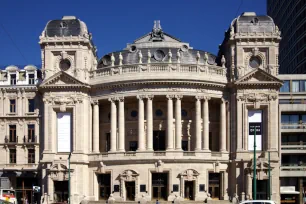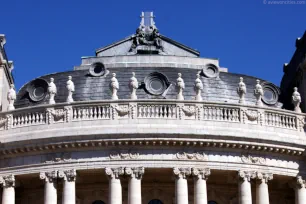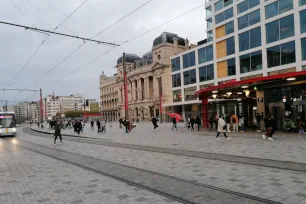The Vlaamse Opera is a Neo-Baroque opera house that was built in 1904-1907 as the Flemish version of the Bourla Theater. In 2007 the opera house was in a deplorable state and its existence was threatened, but a lengthy renovation brought it back to its former splendor.
History and Background

Operas were staged in Antwerp as early as in 1661, first at a hall near the Grote Markt, later in the Tapissierspand, a former market hall that was later replaced by the beautiful Théâtre Royal, now known as the Bourla Theater. The Théâtre Royal was known by locals as a ‘French Opera House’. In the late nineteenth century, Flemish nationalists, led by composer Peter Benoit, campaigned for the construction of a Flemish opera house as a counterweight to the Francophone Bourla Theater.
In 1903 the Antwerp city council commissioned city architect Alexis Van Mechelen with the construction of the ‘Vlaams Lyrisch Theater’, an opera house that would become a symbol of the Flemish movement. Initial plans to build the opera house in the city park were put aside due to strong opposition. Instead, a site at the Kunstlei (Art avenue, now the Italiëlei) was chosen. A covered glass and iron market hall with pointed towers was demolished to make way for the new building.
Construction started in 1904 and just three years later, on October 17, 1907, the Vlaamse Opera officially opened with a performance of ‘De Herbergprinses’, a popular opera created in 1897 by Jan Blockx. Construction on the opera house however continued for several more years.
The Opera House

No expenses were spared for the construction of the Vlaamse Opera. Cost was seemingly not an issue. In fact, most of the complaints of Antwerp residents were directed towards the architectural style of the building: the Neo-Baroque front facade with Beaux-Arts elements was deemed too French.
The opera house was made looking even grander thanks to the similarly styled buildings that flanked the Vlaamse Opera on either side: the Grand hôtel Weber (1901) and the hotel Wagner (1906). Unfortunately the Grand hôtel Weber was damaged by a V2 bomb in 1944 and in 1968-1973 the beautiful domed building was replaced by a (now much hated) high-rise. The opera house was very modern for its time. Colored electric light was used to illuminate the stage, and the building had central heating. It was also very progressive with its use of a single, large foyer that was used by all visitors, rich or not.
The interior is beautifully, albeit not over-abundantly, decorated. The foyer has large marble columns in pink marble. Marble stairs lead to the ground floor and balconies. The ceiling of the foyer is decorated with a painting by Emile Vloors. It was created between 1909 and 1914 and shows a poet with Pegasuses.
Originally the Auditorium could seat about 1500 spectators, later reduced to 1081. It is adorned with beautiful stucco. The highlight is the ceiling painting, created by the Antwerp artist Karel Mertens. Mertens spent almost five years of his life on this masterwork. The painting is called ‘De Rythmus’ and shows the male figure Rythmus – the source of all musical creations – accompanied by the nine muses.
Opera Square

In its early days, the boulevard in front of the Vlaamse Opera was embellished with a flowerbed and a large monument dedicated to Peter Benoit. In 1951 the flowerbed and monument had to make way for the rapidly growing car traffic. Adding insult to injury, a bus stop was later placed smack in front of the entrance to the opera house. Thankfully, the Vlaamse Opera now has a more respectable entry. In 2018 a new square opened in front of the Opera House, the Operaplein (Opera Square). The square was designed by Spanish architect Manuel De Sola Morales and was created on top of a large parking and tunnel.
